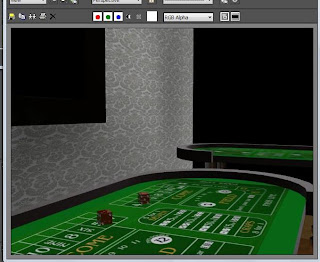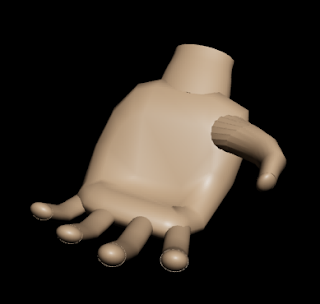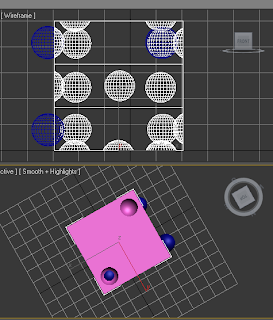Well what can I say about my first few weeks learning 3d modeling techniques? Well for a start I can safely say that I have learnt rather a lot. As I said before, mainly through trial and a lot of error have I managed to find my way anywhere near completing this module. If I was to have my time over again I would definitely not under estimate the amount of time it takes to create an animation and to render out each scene. I tried to preview the reactor animations I had created in the poker room scenes and that every time I tried this 3ds max crashed, whether it was in the labs or on my personal computer. I realise now looking at it, it was probably due to the amount of objects and polygons in my scene that caused this problem. Anyhow, due to not being able to preview the reactor, I tried it out in an external scene and then tried to import the situation into my scene. This didn’t work as well as I’d hoped which I found out by my dice, rolling perfectly in the external test decided just to drop through the table, fly off into oblivion or by just dropping onto the table like rocks. I then (instead of importing the test) tried to recreate the test scenario from scratch using the same process, which I followed in my test. I am still unsure as to why this didn’t work either. I found that when creating the animation it took a ridiculous amount of time to create, roughly 45 minutes for each reactor animation. Again I put this down to not realizing how much 3ds is affected by the amount of assets in a scene.
I would very much like to have my time again, knowing what I know now. Due to the unforeseen circumstances of having to remodel my assets and the various trouble I have had with even understanding the physics behind reactor and similar issues I found that I ran out of time and am not at all pleased with the animation that I have produced. I had high hopes when I embarked on this module and am disappointed to say that I am not a natural 3D modeler and I intend fully to practice and improve my skills in this software which I feel still leave rather an awful lot to be required!
SWOT ANALYSIS
Strengths
The ability to visualise a brief into a storyboard effectively. At the beginning of this project I drew up around eight separate storyboards of different ideas, combinations of films and inspiration. I found this relatively easy and I enjoy drawing and sketching out my ideas before putting them into production. I tried to keep the storyboards I decided upon quite simple as I had no idea what my abilities to create in 3Ds Max would allow me to do at the time. In hind sight this was probably a wise decision considering the amount of time it took me to acquire the basic skills I have now.
During this module I have come to realise that my strengths are;
I have a keen eye for detail and am very much a perfectionist. Although I have included this in the strengths area, I do realise that this could be seen as somewhat counter productive in the sense that looking back at my time I have probably spent far too much time on manipulating numeric values for materials, reflections, refractions, friction and so forth that on the whole didn’t really add to the piece, and rather just increased the render time!
I can generate quite a few different ideas when approached with a brief. Again I have listed this as a strength, although like my previous strength I feel that this hindered me during my time management as I may have spent too long deciding which direction to go.
I feel that now I have recognised these qualities within my way of working, I can be more aware of the way I work and therefore use them to my advantage rather than let them over ride areas in which I need considerably more time.
Weaknesses
During this module I feel that primarily time management and prioritising my tasks have been a major weakness of mine. I have not come across this issue before personally, however, I hope that now I have realised this can be an issue, I will be able to address it in future projects and assignments.
Naivety regarding system requirements and technical aspects. This has been a weakness of mine before, but never has it affected me so acutely. During this module I completely had no point of reference as to how long rendering just a couple of seconds of animation could take. The only animating experience I have previously had has been in flash and although occasionally Flash may decide to ‘quit unexpectedly’, 2D animations can have a great deal of assets pieced together relatively quickly to create a desirable effect compared with 3Ds Max. I also did not foresee my models that I had previously created would be unusable. I have decided in future that I will put aside at least a week within each module to allow for any unforeseen circumstances to be dealt with!
I also dedicated a large portion of my time trying to partition my hard drive on both my macbook and imac so that I was able to download and run 3Ds Max on either machine. This was unsuccessful for a variety of reasons and therefore to work on my project away from the university machines I had to download the program on my 4 year old laptop which did not have the capacity to run the program and so inevitably had major issues with crashes and freezing screens during productions and renders.
Opportunities
Opportunities I feel I have gained through undertaking this project are that having now acquired a very basic knowledge of 3Ds Max and it’s limitations, I fully intend on continuing to practice within both 3Ds Max and other 3D platforms to better improve my own capabilities and I hope that I won’t be scared away from trying new programs no matter how daunting they may be. In the past I feel that unless I have a real need to learn a program, if I find it unbelievably complex, I will most likely try to complete a project in a different way.
A major opportunity I feel I have gained during the past twelve weeks is that no matter how many snags, troubles, problems and unexpected abnormalities that arise, if you persist, there will be a way around the problem, even if it is not how you first expected or even to your liking. This module has helped me to persevere with things that I really struggle with and I am sure that this will help me with future obstacles that I will inevitably run into.
Threats
Threats. Well for a start I feel that visiting family in America although a once in a lifetime opportunity and something I will treasure for a long time, I do not intend on taking so much time away from a module again, in particular one that is incredibly time consuming!
Another threat I feel affected me quite acutely with regard to this semester is family commitments. Due to an immediate family member in a state of deteriorating health I found that I visited home much more regularly than I would have in previous semesters. This I feel could be seen as a threat with regard to my work commitments however life will always be a big influence in your life and I guess I will just have to learn to adapt to circumstances as they arise and spread myself more evenly between the two areas of work and family.











































